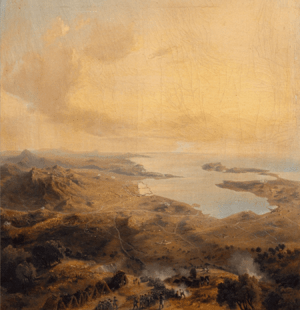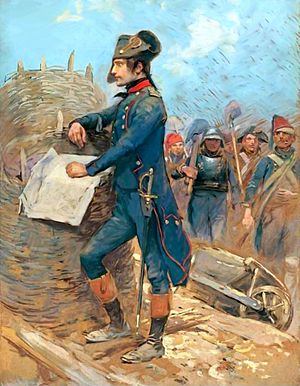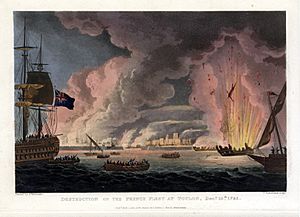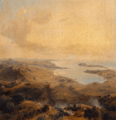Siege of Toulon (1793) facts for kids
The Siege of Toulon (from August 29 to December 19, 1793) was a big military battle during the French Revolutionary Wars. It happened when French Republican forces fought against Royalist rebels in the city of Toulon, in southern France. These Royalists were helped by British and Spanish armies.
This siege was very important because it was where a young officer named Napoleon Bonaparte first became famous. His smart plan to capture key forts around the harbor helped the Republican army win. This victory forced the British and Spanish fleets to leave Toulon. It was also the first time the British Royal Navy was involved in the French Revolution.
Quick facts for kids Siege of Toulon |
|||||||
|---|---|---|---|---|---|---|---|
| Part of the Federalist revolts and other naval operations during the War of the First Coalition | |||||||
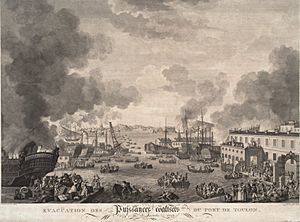 The British evacuation of Toulon in December 1793 |
|||||||
|
|||||||
| Belligerents | |||||||
| Commanders and leaders | |||||||
| Strength | |||||||
| 32,000 | Total 22,000 men 74 ships |
||||||
| Casualties and losses | |||||||
|
|
Total 4,600 |
||||||
Contents
Why the Siege Happened
After some political changes in France in June 1793, many cities rebelled against the new government. These were called the Federalist revolts. In Toulon, the local revolutionaries were replaced by people who supported the old French monarchy (Royalists).
When the Royalists heard that other cities had been taken back by the revolutionaries, they asked for help. They reached out to the British and Spanish navies. On August 28, 1793, British Admiral Sir Samuel Hood and Spanish Admiral Juan de Lángara arrived with about 13,000 soldiers. These soldiers were from Britain, Spain, Naples, and Sardinia.
The Royalists in Toulon then gave control of the city's port to the British navy. They raised the royal flag and declared an eight-year-old boy, Louis XVII, as the new king of France.
This was a huge problem for the French Republic. Toulon had a very important naval base and 26 warships. This was about one-third of the entire French Navy! If the Republic lost this port and its ships, they couldn't fight the British and their allies at sea. Losing Toulon would also encourage other cities to rebel. The French Republic needed to get Toulon back to protect its navy and its reputation.
The Siege Begins
The French Republican army, led by General Jean François Carteaux, arrived at Toulon on September 8. They had already taken back other cities like Avignon and Marseille. They joined forces with another army of 6,000 men and 3,000 sailors who refused to work for the British.
The main artillery commander was injured, so a young captain named Napoleon Bonaparte was put in charge of the cannons. Napoleon was in the area by chance and was recommended by his friends who were powerful government representatives. Even though some people didn't like him, Napoleon was given the job.
Napoleon quickly gathered many cannons and equipment from nearby areas. He even got people who had recently rebelled to help by supplying animals and supplies. He managed to get 100 cannons for the army. He also trained many soldiers to use the artillery. Napoleon was very dedicated, but he was worried about the delays caused by other officers' mistakes. He even wrote a letter asking for a better general to lead the artillery.
After looking around, Napoleon came up with a plan. He wanted to capture two forts, l'Eguillette and Balaguier, on a hill called Cairo. If they took these forts, they could stop supplies from reaching the city by sea. General Carteaux sent a small group to attack on September 22, but they failed.
The allies (British and Spanish) then built a new, very strong fort on the hill called "Fort Mulgrave," named after the British commander. It was so strong that the French called it "Little Gibraltar."
Napoleon was not happy with just one cannon battery. He set up more batteries, including a powerful one called "of the Convention." He was promoted to Chief of Battalion on October 19.
On November 11, General Carteaux was replaced by a former doctor, François Amédée Doppet. Doppet was not a good military leader, and he failed an attack on Fort Mulgrave. He soon resigned.
The next general, Jacques François Dugommier, was a skilled soldier. He immediately saw how good Napoleon's plan was. He started building more cannon batteries to prepare for the attack on Little Gibraltar.
Under heavy fire from the French cannons, the British and Neapolitan soldiers tried to attack one of the French batteries. But a counter-attack led by Dugommier and Napoleon pushed them back. The British general, Charles O'Hara, was captured.
On the night of December 16, Dugommier, General La Poype, and Napoleon (who was now a colonel) launched a big attack. The fighting for Little Gibraltar lasted all night. Napoleon was even injured in the leg by a British soldier's bayonet. By morning, the French had taken the fort. This allowed them to place cannons there, which forced the British to leave l'Eguillette and Balaguier. At the same time, La Poype captured other important forts. The allies then decided to leave Toulon by sea.
Destroying the French Fleet
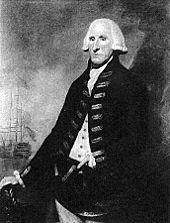
As the allies left, they wanted to destroy the French warships and the naval base so the French Republicans couldn't use them. Spanish Admiral Lángara ordered his men to burn the French fleet. British Commodore Sir Sidney Smith volunteered to help.
Smith and his men went into the arsenal (where ships are built and repaired). They set fire to warehouses and stores, creating a huge fire across the harbor. One of their fire ships, HMS Vulcan, exploded, sending cannons firing one last time at the French positions.
As Smith's boats left, two French ships filled with gunpowder exploded unexpectedly. This caused a huge blast, sinking some of the British boats. Smith tried to go back to destroy more ships, but Republican soldiers had already taken control of the Old Arsenal. Instead, he set fire to two disarmed French ships that were being used as prison ships. The French prisoners on board were safely taken to shore first.
Evacuating the City
While the fires raged, British ships, led by Captain George Elphinstone, worked to evacuate the allied soldiers from the city. They also rescued thousands of French Royalists who were fleeing from the advancing Republican army. Many civilians rushed to the waterfront in a panic, trying to escape.
In total, the British fleet saved 14,877 people from Toulon. Witnesses said there was chaos as people tried to get on the ships, with some being crushed or drowning.
What Happened Next
The Republican troops entered Toulon on December 19. After the city was taken, many Royalists were punished. It's believed that hundreds of prisoners were shot or killed. Napoleon, who was recovering from his injury, was not there for this.
Napoleon was promoted to brigadier general on December 22. He then left for his new job as the artillery commander for the French army in Italy. There is a gate in Toulon, called the Porte d'Italie (Gate of Italy), that remembers his departure.
Images for kids
-
Admiral Sir Samuel Hood who commanded the British naval forces defending the city.
See also
 In Spanish: Sitio de Tolón (1793) para niños
In Spanish: Sitio de Tolón (1793) para niños


